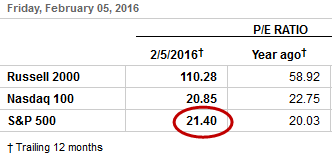Monday was another dramatic day on Wall Street, as the day began with a 400+ point drop on the Dow Jones Industrial Average (DJIA), with oil prices falling once again below $30 per barrel. By the end of the day, the stock market recovered to "only" a 178 point loss. Analysts are mostly confused about why the stock market has been falling recently, and I frequently see them on tv scratching their heads wondering why such a "small economy" like China's is having such a big effect on Wall Street.
As regular readers know, Generational Dynamics predicts that we're headed for a global financial panic and crisis. According to Friday's Wall Street Journal, the S&P 500 Price/Earnings index (stock valuations index) on Friday morning (February 5) was at an astronomically high 21.41. This is far above the historical average of 14, indicating that the stock market is in a huge bubble that could burst at any time. Generational Dynamics predicts that the P/E ratio will fall to the 5-6 range or lower, which is where it was as recently as 1982, resulting in a Dow Jones Industrial Average of 3000 or lower.

If you compare stock price and P/E ratio changes in the last month, there are some interesting observations. Last week, on the morning of February 5, the Dow was at 16417 and the S&P 500 P/E ratio was at 21.40.
A month ago, on the morning of January 8, stock prices were higher, but the P/E ratio was lower. Specifically, the Dow was at 16514, and the P/E ratio was 21.03.
Now that should be impossible. The P/E ratio is, well, a ratio of stock prices to earnings, and so if stock prices fall, then the P/E ratio should fall as well.
But of course, that's not always true, because the earnings may change as well. What's been happening is that fourth quarter (4Q2015) earnings have been coming out in the last month,In fact, 63% of S&P 500 companies reported results as of Friday morning, and Q4 earnings are on track to decline 4.1%. This is even worse than the 3.7% decline that analysts had been predicting at the beginning of January.
The 4.1% decline in Q4 earnings would be the biggest drop in six years, and it follows a 0.8% decline in Q3. Revenue figures followed the same path, with revenue falling 3.5% in Q4, after falling 4.4% in Q3.
And so, the reason that the P/E ratio increased in the last month, despite the fact that stock prices have fallen, is that earnings have fallen even more.
If earnings decline two quarters in a row, then it's called an "earnings recession." We won't know for several months whether the GDP also fell for two quarters in a row, which would be the definition of an "economic recession."
The stock market has been in a bubble for several years. Although analysts are always claiming that "this time it's different," the fact is that it's never different, and Generational Dynamics is predicting a stock market panic and crash, with the Dow falling to 3000 or lower.
DYI
No comments:
Post a Comment